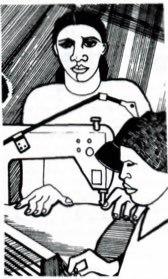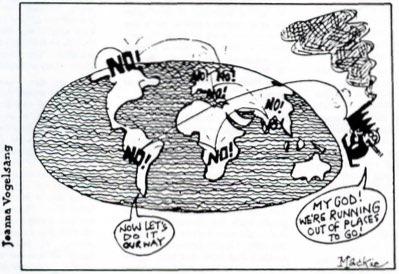 WOMEN WORKERS ACTIONS IN THE PHILIPPINES: AN UPDATE
WOMEN WORKERS ACTIONS IN THE PHILIPPINES: AN UPDATE
by Marilee Karl
In June 1982, the first big general strike ever held in a Free Trade Zone in the Third World took place in Bataan, the largest export processing zone in the Philippines. Over 10,000 workers from 23 factories put down their work in an unprecedented action which sent shock waves through the government and the American, European and
Japanese multinational corporation operating in the zone. Since a good three-quarters of the workers there are women, this strike also shattered the myth of the docile Asian woman worker.
It began on May 8, when 200 workers of Inter-Asia Container Industries, a Mitsubishi joint venture, walked off their jobs to protest an increased work load. The management of the factory, which produced synthetic fiber sacks, had ordered an increase in the number of looms operated by each worker from four to six. For several weeks the workers resisted a back to work order in spite of intervention by the police. On June 3, the police attacked the picketing workers, injuring several and arresting 54. Only seven women remained on the picket line.
The news spread quickly to the other factories of the zone and the next day 3,000 other workers put down their work in protest. By the third day, over 10,000 workers had walked out of the factories in a general sympathy strike with the workers of Inter-Asia. Taken by surprise, the government and the multinationals were forced to release
the arrested workers, take back all strikers without penalty and reduce the work load at Inter-Asia to five looms per worker. The workers movement throughout the country was given a tremendous boost by this show of support and soUdarity.
The government retaliated a few weeks later by issuing a presidential order prohibiting strikes in the semi-conductor industry. On August 13, it arrested the top leadership of the KMU (First of May Movement). By September more than 200 labour organizers of this independent workers movement (as opposed to the government-controlled unions) had been arrested. As of January 1983, they are still in detention.

The international mass media — largely controlled by multinational interests — virtually ignored both the strike and the repression of the workers which followed it. In spite of this repression, there has been a series of strikes and labour activities throughout the Philippines during the last months of 1982 and early 1983. Workers in the textile,
garment and electronics industries, 75 to 90 percent of whom are women, have been among the most active.
Redson Textile Manufacturing Corporation is the number two exporter of T-shirts in the Philippines. Ninety-nine percent of the workers there are women and their factory has been the scene of organizing activities for the past few years. In 1979, the workers formed their own union which won out against the government controlled or "yellow"
union. When the management refused to recognize the union, the workers finally went on strike in November 1981. All the workers but 20 walked off the job for 23 days until the management agreed to recognition. In September 1982, the union picketed the factory to protest the lay off of 600 workers while union leaders, all of whom are
women, negotiated with the management until they agreed to take back all 600 workers. Nevertheless, the union is having continuous problems with the management which has not yet signed the collective bargaining agreement and which is trying to disunite the workers by suspending active union leaders and workers, layoffs, rotating
shifts and staggered rest days.

Women labour organizers from the Free Trade Zones in the Philippines organized their own workshop from 10 to 12 December 1982 in order to meet and discuss the particular problems of women workers. They are concerned with making sure that women workers issues are incorporated into the agenda of the labour unions. During the workshop they focused on the historical and sociological situation of women and the question of why women have a secondary place in society. Among the problems they are trying to deal with are wages and working conditions, sexual harassment on the job, family constraints and responsibilities, feudalistic male attitudes towards women,
building solidarity among women workers, developing more women labour organizers.
In Manila women workers from a number of textile and electronics factories have come together to plan the setting up of a Center for Women Workers. They want to supply it with reading and study materials on the situation and activities of women workers in other countries. The Center will also serve to build up support and solidarity among women workers in the Philippines and to exchange information and solidarity with those in other countries.


